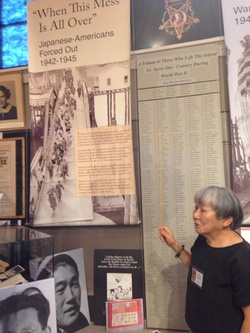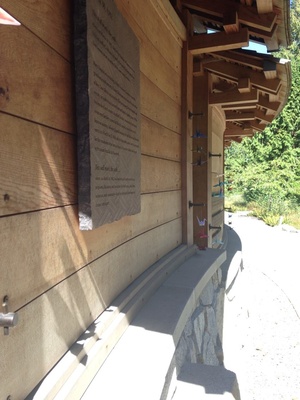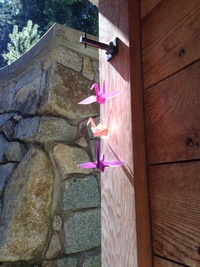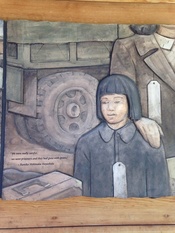It’s hard to describe the shock of recognition when sepia history meets full-color present, when they can align so precisely. That’s one of the many gifts that the Bainbridge Island Japanese American Exclusion Memorial gives to its visitors.
We’re standing under a large vertically hung banner, a sepia photographic replica of people walking down a ferry dock. It’s a picture we know well, as a famous historic photo of the first wartime forced removal of Japanese Americans. Our tour guide, Lilly, is giving us a tour of the Bainbridge Island Historical Museum. We look up at the photo, and Lilly says something unexpected. She looks around, finds a long wooden pointer. “And here,” she says, pointing to a 7-year-old child in the picture who’s holding the hands of her younger siblings. “That’s me.”
We’re at the entrance to the Bainbridge Island Japanese Exclusion Memorial. We’re especially lucky to be visiting the Memorial with Clarence Moriwaki and Lilly Kodama, co-presidents of the Bainbridge Island Japanese American Exclusion Memorial Association. They are two of the many community leaders responsible for the creation, development, and maintenance of the Memorial. Lilly was one of the “test case” Japanese Americans, among the very first Japanese Americans to be forcibly removed during World War II. I’m with my uncle and auntie, Hiroshi and Sadako Kashiwagi, as well as other Asian American cast and crew members from the film Infinity and Chashu Ramen. Thanks to Islander (and Nikkei filmmmaker) Karen Matsumoto, we’re on a tour, a mini-pilgrimage to visit one of the places where incarceration history begins.
We begin by gathering under the roof of a beautiful wooden informational kiosk. Clarence is telling us about the “4H’s” of the memorial: history, honor, healing, and heart. Heart, for so much of the devotion that went into the construction of the memorial. So many individuals donated their time and talents, including Johnpaul Jones, the pro bono Seattle architect of the memorial who lives on Bainbridge Island, recent recipient of the National Humanities Medal from President Obama. Honor and History, to recognize the historical significance of this particular site and this community: the 276 Japanese Americans from Bainbridge Island were the very first of the 120,000 to be forcibly removed from the West Coast. And Healing, for those incarcerated, their descendants, and the Island community itself, as well as the larger population of Japanese Americans and Americans.
As I’m listening to Clarence, I’m looking at the support beams on the kiosk and I reach out to touch the wood. I am shocked at how smooth it feels, almost too smooth to be real wood. The crew, Clarence says, didn’t use sandpaper for the wood on the Alaskan yellow cedar pavilion. They planed the entire structure by hand, with increasingly sharper tools. The result is wood that seems formidable at first but then surprisingly welcoming.
We walk down on a wooden bridge that curves around the trees, onto a gravel path, and towards a curving wall. Clarence tells us more about the intentions behind the design: the granite gravel is there so that visitors can hear their own footsteps, and place their footsteps into this particular historical path. The memorial wall is 276 feet long, one for each Japanese American on Bainbridge Island at the start of World War II. Granite was used in part of the memorial wall because it’s the bedrock of the region’s geology, symbolically representing the Japanese American community’s solid foundation with the greater Bainbridge Island community. The wooden part of the wall is constructed from one large old-growth redwood tree, reclaimed from the ocean after a tsunami from Japan washed it away. The cost of reclamation, too, was absorbed by the construction company. The wall is curved, rather than linear, to depict the cyclical nature of time and experience. There is a physical break near the end of the wall to represent the lives interrupted by the exclusion and incarceration.
Visitors walk downhill along the curve, towards the water. Strings of origami cranes hang from parts of the wall. We’re not walking just to commemorate the steps of those whom were the first in the nation to be forcibly removed. We’re actually retracing the path that they took, built on the site of the former road that lead to the old Eagledale ferry dock. The dock is no longer there, but we’re walking the same path. It’s another moment of recognition when Lilly points to her own name on the wall, listed among there the names of the other 275, including their ages.
Near the end of the wall, Clarence tells us another story about the memorial site. Back in 2002, before the construction of the memorial, there was a ceremony at the site commemorating the 60th anniversary of the Bainbridge Islanders’ March 30th forced departure. At one point, the names of all 276 Islanders were read out loud. Suddenly, crows began to gather by the dozens in the trees above the crowd, with their calls growing louder—and at times even deafening—as the reading went on. When a respectful moment of silence began after the last name was read, as if a switch was flipped off, the crows suddenly went silent. Later, a Native American friend told Clarence, “Among our people, we believe that black birds like crows represent the spirits of our ancestors.” “When I heard that,” says Clarence, “the hairs stood up on the back of my neck—since during the entire 90 minute ceremony, the only time there were any crows present at all was during the reading of the names.”
The connections between Native American and Japanese American history have found a beautiful synergy in the Bainbridge memorial. I’m particularly struck by the historical solidarity expressed by the Native American architect, Johnpaul Jones. When the New York Times asked Jones in a 2011 interview about his inspiration for the wall, he spoke of displacement and exclusion. “I’m American Indian, and I understand being sent away from your homeland. I consider the wall a place to honor them for what they lost.” And just recently, in a law introduced by Washington State representative Derek Kilmer and signed by President Obama, the memorial was officially renamed to include the word “exclusion.”
What does it means to visit the memorial as a Nikkei? Kerwin Berk, the director of Infinity and Chashu Ramen, put it best: “One of the unexpected benefits of making [the movie] is that during the screening process we’ve met so many new and wonderful people in extended Japanese American communities such as Bainbridge Island, whose historical significance is not lost on the cast and crew. Many of those involved in the film are Nikkei. And, our families were sent to places such as Topaz, Heart Mountain, Poston, and Rohwer. One cast member was in Tule Lake, another in Manzanar. The memorial was especially moving because it’s not just about history for us—it’s about family.”
© 2014 Tamiko Nimura










